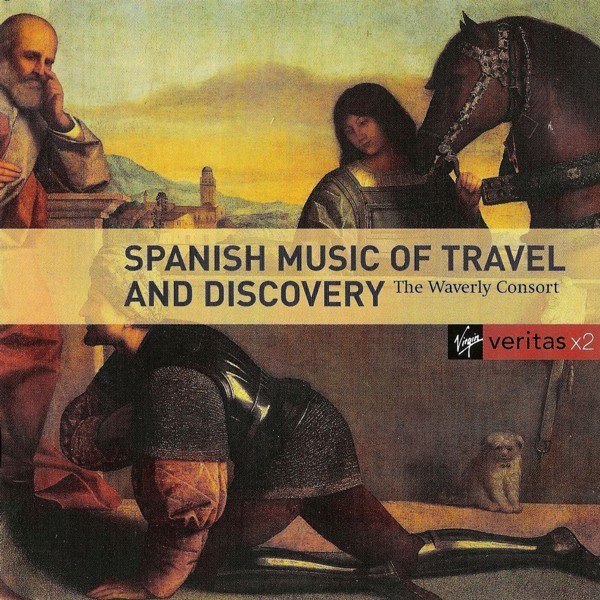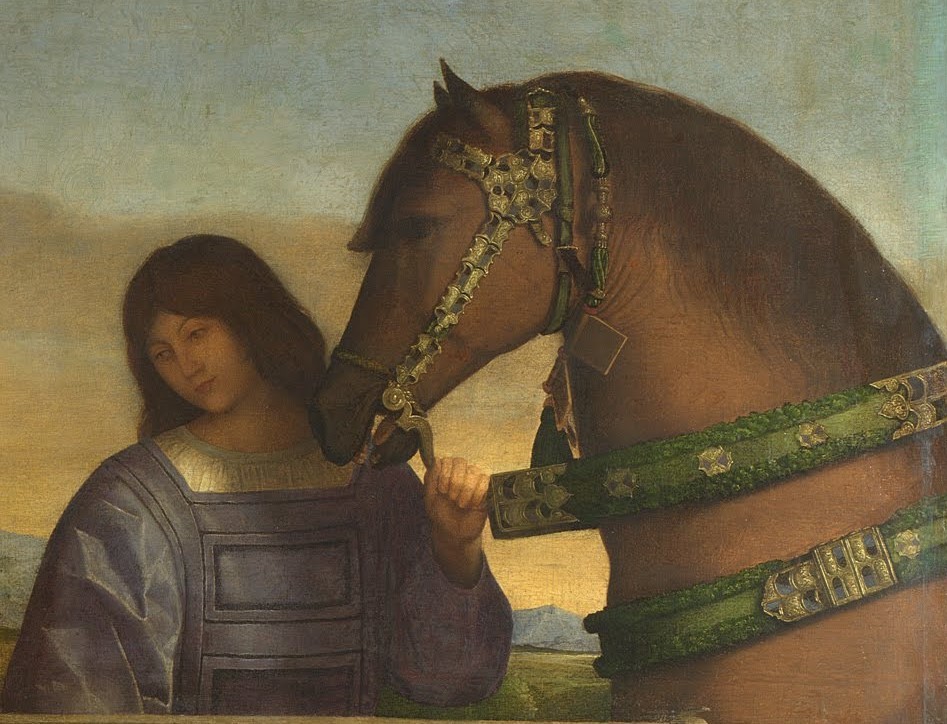
medieval.org
amazon.com
Virgin "VeritasX2" 7243 5 61815 2 6
2000

medieval.org
amazon.com
Virgin "VeritasX2" 7243 5 61815 2 6
2000
CD1 [51:17] 1492. Music from the Age of Discovery
circa 1492: two anonymous Italian songs
1. Ayo visto lo mappamundi [2:52]
2. Viva el gran Re Don Fernando [3:01]
Musical reflection on Moorish Spain
3. Una sañosa porfia [3:10] Juan del ENCINA
4.
Improvisations on Tres moricas m'enamoran anon. Spanish —
— Tres moricas me enamoran Diego FERNÁNDEZ [3:40]
5. B'tayhi-M'saddar [3:47] anon. Arab-Andalusian
Ferdinand and Isabella.
Songs and dances from the Cancionero de Palacio
6. Nunca fué pena mayor [3:30] Johannes URREDA
7. Ay Santa Maria [1:18] anon. Spanish
8. Virgen bendita sin par [2:21] anon. Spanish
9. El Cervel [1:05] anon. Spanish
10. En memoria d'Alixandre [2:56] Juan de ANCHIETA
11. La Alta (‘La Spagna’) [1:22] Francisco de la TORRE
12. Pase el agoa, ma Julietta [1:29] anon. Spanish
13. Oy comamos y bebamos [2:12] Juan del ENCINA
The Expulsion: two Judeo-Spanish songs
14. El paso del Mar Rojo [5:12]
15. ¡Ah, el novio no quere dinero! [2:32]
Epilogue: Ayo visto lo mappamundi
16. Kyrie: Ayo visto lo mappamundi [3:38] Johannes CORNAGO
17. Ayo visto lo mappamundi (reprise) [3:28]
18. Improvisations on Ayo visto lo mappamundi [3:43]
CD2 [65:11] Traveler
Pilgrim Songs from the “Llibre Vermell” of Montserrat [33:20]
(Catalonia, 14th century)
1. O Virgo splendens [2:47]
LV 1
2. Stella splendens in monte [5:44]
LV 2
3. Laudemus virginem —
Splendens ceptigera [1:34]
LV 3 —
LV 4
4. Los set gotxs recomptarem [5:50]
LV 5
5. Cuncti simus concanentes [3:22]
LV 6
6. Polorum regina [3:25]
LV 7
7. Mariam matrem virginem [4:45]
LV 8
8. Imperayritz de la ciutat ioyosa [2:14]
LV 9
9. Ad mortem festinamus [3:48]
LV 10
Galician-Portuguese Lyrics (13th century) [16:20]
10 - [4:22]
Ondas do mar de Vigo
ca I
Mandad' ei comigo
ca II
11 - [5:31]
Mia irmana fremosa
ca III
Ay Deus se sab' ora
ca IV
12 - [6:35]
Quantas sabades amar amigo
ca V
Eno sagrado en Vigo
ca VI
Ay ondas eu vin veer
ca VII
13. “Santa Maria strela do dia” [3:27]
CSM 100
Three Judeo-Spanish Ballads
14. El buesca del padre [5:36] “The Father Quest”
15. Las hermanas reina y cautiva [2:43] “The Sisters, Queen and Captive”
16. El sueño de la hija [3:27] “The Daughter's Dream”

THE WAVERLY CONSORT
Michael Jaffee
Shannon Anderson — soprano
Tamara Crout — soprano
Rita Lilly — soprano
Kathy Theil — soprano
Timothy Leigh Evans — tenor, tambourine
Larry Lipnik — tenor, baritone, tenor viol, recorder, bowed psaltery
John Olund — tenor, claves
John Shankweiler — tenor
Joel Frederiksen — bass, lute
Kay Jaffee — recorders, harp, gemshorn, organetto, hammered psaltery, chimes, drone fiddle, percussion
Michael Jaffee — citole, vihuela, hurdy-gurdy, saz, drum, medieval cup bells, plucked psaltery, small harp, handbells
Rosamund Morley — viols, vielle, kemençe, finger cymbals
Tom Zajac — sacbut, shawm, recorders, flutes, panpipes, cornamuse, hurdy-gurdy
with
Michael Hinton, percussion
George Mgrdichian,oud
Steven Lundhal — sacbut (CD1, 9)
Producers:
Timothy Martyn (CD1) |
Timothy Martyn & Christianne Orto (CD2)
Balance engineers:
Robert Rapley (CD1) | Carl Talbot (CD2)
Recording:
Sommer Center Performance at Concordia College, Bronxville, New York, June 1995 (CD2)
Cover: Vincenzo Catena (active 1506-1531).
A Warrior adoring the Infant Christ and the Virgin, after 1520 (detail)
The National Gallery, London
Design UNA (London) designers
Notes Virgin Classics, Adélaïde de Place
Übersetzung Heidi Fritz
℗ 1992 (CD1), 1995 (CD2) The copyright in these sound recordings is
owned by Angel Records under exclusive licence to EMI Records
Ltd/Virgin Classics.
This compilation ℗ & © 2000
EMI Records Ltd/Virgin Classics. www.virginclassics.com

SPANISH MUSIC OF TRAVEL AND DISCOVERY
Maps of the world inspired Columbus's ‘enterprise of the Indies’ in 1492.
In the Aragonese court of Naples around 1450, Ayo visto to mappamundi
was a popular song and Johannes Cornago must have learnt it there
before returning to Spain in the household of Ferdinand of Aragon.
1492
also saw the conquest of Granada under Ferdinand and Isabella,
following which only a Catholic allegiance was permitted. The expelled
Muslims and Jews resettled in northern Africa and Asia Minor and
although El paso del Mar Rojo, the story of the Exodus, comes
from Turkey, it is told through the voices of those who still thought of
Spain as their home. The surviving Jewish songs were sung mainly by
women at social gatherings and at appropriate religious festivals, and
it is ironic that there was a far wider dissemination of traditional
Spanish ballads via the Sephardic Jews than through the conquistadores.
The
‘Cancionero Musical de Palacio’ (Palace Songbook) contains songs by
major Spanish composers plus admired foreign ones, such as the Flemish
Johannes Urreda, whose Nunca fue pena mayor was extremely popular.
Ay santa Maria and Virgen, bendita sin par are song-motets used for private devotion at the court of the Catholic Kings.
Some pieces, such as En memoria d'Alixandre are designed to flatter,
while others such as Oy comamos y bebamos are deliberately bacchanalian.
The
fourteenth-century ‘Llibre Vermell’ (Red Book) from the mountain-top
monastery of Montserrat, near Barcelona, includes ten devotional
‘pilgrim’ songs addressed to the Virgin. Half these are in the form of
the virelai, a French song style that may have originated in northern Africa.
Three of the remaining pieces (O virgo splendens, Laudemus virginem and Splendens ceptigera)
are canons in two or three parts. Of the two vernacular songs, the ... Catalan ballad, Los set gotxs,
is reminiscent of the Italian Ars Nova. The text of Imperayritz
is in Occitan, suggesting that it originated from somewhere in southern
France. Some of the pieces are circle dances, indicating combined
recreational and devotional purposes.
The Galician-Portuguese
language, which dominated the vernacular poetry of the Iberian peninsula
between the twelfth and fifteenth centuries, finds typical
representation in Martin Codax's Cantigas d'amigo. Here, the
poets, speaking through women, project the abstract sentiments of
unrequited love into a feminine perspective. Portugal's maritime
importance is also reflected in the number of metaphors concerning the
sea. In Santa Maria, strela do dia, Alfonso X, as aspiring Holy Roman Emperor, hopes to merit the grace of Mary's redemptive love.
